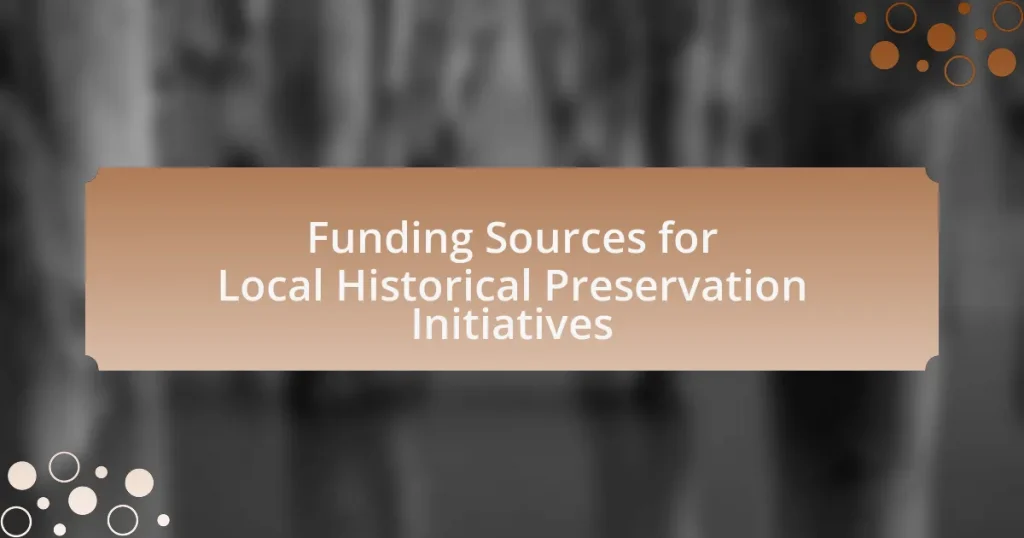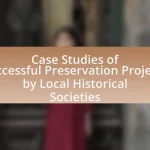The article focuses on funding sources for local historical preservation initiatives, highlighting the importance of government grants, private donations, and nonprofit organizations in supporting these efforts. It details how government grants from entities like the National Park Service provide essential financial backing for restoration and educational programs. Additionally, it discusses the role of private foundations, such as the Getty Foundation and the National Trust for Historic Preservation, in funding preservation projects. The article also examines community fundraising strategies, the challenges faced in securing funding, and best practices for enhancing funding success, emphasizing the significance of community involvement and transparency in the funding process.
What are the primary funding sources for local historical preservation initiatives?
The primary funding sources for local historical preservation initiatives include government grants, private donations, and nonprofit organizations. Government grants, such as those from the National Park Service and state historic preservation offices, provide significant financial support for preservation projects. Private donations from individuals and businesses often contribute to funding efforts, while nonprofit organizations, like the National Trust for Historic Preservation, offer grants and resources to assist local initiatives. These funding sources are essential for maintaining and restoring historical sites, ensuring their preservation for future generations.
How do government grants support local historical preservation initiatives?
Government grants support local historical preservation initiatives by providing essential funding that enables communities to restore, maintain, and promote their historical sites. These grants often cover costs related to research, restoration, and educational programs, ensuring that local heritage is preserved for future generations. For instance, the National Park Service administers the Historic Preservation Fund, which allocates millions of dollars annually to state and local governments for preservation projects, demonstrating the federal commitment to safeguarding historical resources.
What types of government grants are available for historical preservation?
Various types of government grants are available for historical preservation, including federal, state, and local grants. Federal grants, such as those offered by the National Park Service through the Historic Preservation Fund, support projects that preserve historic sites and structures. State governments also provide grants through their respective historic preservation offices, often funded by state lottery proceeds or dedicated taxes. Additionally, local governments may offer grants or matching funds for preservation initiatives within their jurisdictions. These grants are typically aimed at restoring, rehabilitating, or maintaining historic properties, ensuring their protection and continued use for future generations.
How can local organizations apply for government grants?
Local organizations can apply for government grants by identifying relevant grant programs, preparing a detailed proposal, and submitting the application through the appropriate channels. Organizations should first research federal, state, and local government grant opportunities that align with their historical preservation initiatives, such as those offered by the National Park Service or state historical societies. The proposal must clearly outline the project goals, budget, and expected outcomes, demonstrating how the initiative will benefit the community and preserve local history. Applications are typically submitted online or via mail, depending on the specific grant program’s requirements.
What role do private foundations play in funding historical preservation?
Private foundations play a crucial role in funding historical preservation by providing financial resources that support the restoration and maintenance of historical sites and artifacts. These foundations often allocate grants specifically for preservation projects, enabling local communities to protect their cultural heritage. For instance, the National Trust for Historic Preservation, a prominent private foundation, has awarded millions in grants to various preservation initiatives across the United States, demonstrating the significant impact of private funding on preserving historical landmarks.
Which private foundations are known for supporting historical initiatives?
The Getty Foundation is known for supporting historical initiatives, particularly in the preservation of cultural heritage. It provides grants for projects that enhance the understanding and preservation of art and architecture, contributing significantly to historical research and conservation efforts. Additionally, the National Trust for Historic Preservation offers funding and resources aimed at preserving historic sites across the United States, supporting local initiatives that protect and celebrate historical landmarks.
What are the application processes for private foundation funding?
The application processes for private foundation funding typically involve several key steps. First, organizations must identify suitable private foundations that align with their mission and funding needs. Next, applicants usually need to submit a letter of inquiry or a proposal that outlines their project, budget, and expected outcomes. Many foundations require specific documentation, such as proof of nonprofit status, financial statements, and a detailed project plan. After submission, foundations may conduct a review process, which can include interviews or site visits. Finally, if approved, organizations will receive funding and must adhere to reporting requirements to demonstrate the impact of the grant.
How do community fundraising efforts contribute to preservation initiatives?
Community fundraising efforts significantly enhance preservation initiatives by providing essential financial resources and fostering local engagement. These efforts mobilize community members to contribute funds, which can be directly allocated to restoration projects, maintenance of historical sites, and educational programs. For instance, a study by the National Trust for Historic Preservation found that local fundraising campaigns raised over $1 billion for preservation projects across the United States in a single year, demonstrating the substantial impact of community involvement. Additionally, such initiatives cultivate a sense of ownership and pride among residents, leading to increased volunteerism and advocacy for local heritage, which further supports the sustainability of preservation efforts.
What strategies can communities use to raise funds for historical preservation?
Communities can utilize various strategies to raise funds for historical preservation, including grant applications, fundraising events, and partnerships with local businesses. Grant applications to organizations such as the National Trust for Historic Preservation can provide significant financial support, as these grants are specifically designed to assist in the preservation of historical sites. Fundraising events, such as auctions, bake sales, or historical reenactments, can engage the community and generate funds while raising awareness about the importance of preservation. Additionally, forming partnerships with local businesses can lead to sponsorship opportunities, where businesses contribute financially in exchange for promotional benefits, thereby fostering a collaborative approach to historical preservation.
How effective are crowdfunding platforms for local historical projects?
Crowdfunding platforms are highly effective for local historical projects, as they provide accessible funding opportunities and foster community engagement. Research indicates that projects utilizing crowdfunding can achieve funding success rates of up to 40%, significantly higher than traditional grant applications, which often have lower approval rates. Additionally, platforms like Kickstarter and GoFundMe enable project creators to reach a broader audience, allowing them to raise funds from individuals who are passionate about local history. This model not only secures financial support but also builds a community around the project, enhancing its visibility and potential for success.
What challenges do local historical preservation initiatives face in securing funding?
Local historical preservation initiatives face significant challenges in securing funding primarily due to limited financial resources and competing priorities. Many local governments prioritize immediate economic needs over preservation efforts, leading to insufficient budget allocations for historical projects. Additionally, the reliance on grants and donations can be problematic, as these sources are often highly competitive and may not provide consistent support. According to the National Trust for Historic Preservation, only 10% of preservation projects receive federal funding, highlighting the scarcity of available financial assistance. Furthermore, public awareness and support for preservation initiatives can be low, making it difficult to rally community backing for funding efforts.
Why is competition for funding a significant issue for preservation initiatives?
Competition for funding is a significant issue for preservation initiatives because it limits the financial resources available for maintaining and restoring historical sites. Many preservation projects rely on grants, donations, and government funding, which are often scarce and highly sought after. For instance, the National Trust for Historic Preservation reported that in 2020, only 30% of applicants received funding for their projects, highlighting the intense competition among various initiatives. This scarcity can lead to delays in preservation efforts, reduced project scopes, or even the abandonment of important historical sites, ultimately threatening cultural heritage.
How can organizations differentiate themselves to attract funding?
Organizations can differentiate themselves to attract funding by showcasing unique value propositions that align with funders’ priorities. For instance, emphasizing innovative preservation techniques or community engagement strategies can set an organization apart. Research indicates that organizations that effectively communicate their impact and demonstrate measurable outcomes are more likely to secure funding; a study by the National Trust for Historic Preservation found that projects with clear community benefits received 30% more funding than those without. Additionally, building strong partnerships with local stakeholders can enhance credibility and attract diverse funding sources, as collaboration often leads to increased visibility and shared resources.
What are the common pitfalls in funding applications for preservation projects?
Common pitfalls in funding applications for preservation projects include lack of clarity in project goals, insufficient detail in budget proposals, and failure to demonstrate community impact. Clarity in project goals is essential, as vague objectives can lead to misunderstandings about the project’s purpose and outcomes. Insufficient detail in budget proposals can raise concerns about financial management and feasibility, making funders hesitant to invest. Additionally, failing to demonstrate how the project will benefit the community can result in applications being viewed as less compelling, as funders often prioritize projects that have a clear positive impact on local populations.
How do economic downturns impact funding for historical preservation?
Economic downturns significantly reduce funding for historical preservation. During such periods, government budgets often face cuts, leading to decreased allocations for preservation projects. For instance, the National Trust for Historic Preservation reported that during the 2008 financial crisis, many state and local governments slashed funding for heritage programs by up to 50%. Additionally, private donations typically decline as individuals and corporations prioritize essential expenditures over philanthropic contributions. This dual impact results in fewer resources available for maintaining and restoring historical sites, ultimately jeopardizing their preservation.
What strategies can organizations employ to sustain funding during economic challenges?
Organizations can sustain funding during economic challenges by diversifying their funding sources. This strategy involves seeking a mix of public grants, private donations, corporate sponsorships, and crowdfunding to reduce reliance on any single source. For instance, a study by the National Trust for Historic Preservation highlights that organizations that engage in multiple fundraising activities are more resilient during economic downturns, as they can adapt to fluctuations in specific funding streams. Additionally, building strong relationships with local businesses and community members can enhance support and create a network of financial backing that is crucial during tough economic times.
How can historical preservation initiatives adapt to changing economic conditions?
Historical preservation initiatives can adapt to changing economic conditions by diversifying funding sources and leveraging community engagement. By seeking grants from government programs, private foundations, and crowdfunding platforms, these initiatives can secure financial support even during economic downturns. For instance, the National Trust for Historic Preservation reports that successful projects often combine multiple funding streams, which mitigates risks associated with reliance on a single source. Additionally, fostering partnerships with local businesses and organizations can enhance community investment and support, ensuring that preservation efforts remain viable despite fluctuating economic circumstances.
What best practices can enhance funding success for local historical preservation initiatives?
To enhance funding success for local historical preservation initiatives, organizations should prioritize building strong community partnerships. Engaging local stakeholders, including residents, businesses, and civic groups, fosters a sense of ownership and support for preservation efforts. Research indicates that initiatives with broad community backing are more likely to secure funding; for example, the National Trust for Historic Preservation highlights that projects with active community involvement often see increased grant applications and donations. Additionally, developing a clear and compelling narrative about the historical significance and potential impact of the initiative can attract funders. A well-articulated story that connects the project to local identity and heritage resonates with potential donors, as evidenced by successful campaigns documented in preservation case studies. Lastly, diversifying funding sources by applying for grants, seeking corporate sponsorships, and utilizing crowdfunding platforms can significantly improve financial prospects, as demonstrated by various successful historical preservation projects across the United States.
How can organizations build strong relationships with potential funders?
Organizations can build strong relationships with potential funders by establishing clear communication and demonstrating alignment with the funders’ goals. Regularly sharing updates on projects, showcasing impact through data and stories, and actively engaging funders in the organization’s mission fosters trust and collaboration. Research indicates that organizations that maintain consistent communication and provide transparent reporting are more likely to secure ongoing support, as evidenced by a study from the Nonprofit Finance Fund, which found that 75% of funders value regular updates on project progress.
What communication strategies are effective in engaging funders?
Effective communication strategies for engaging funders include personalized outreach, transparent reporting, and storytelling that highlights impact. Personalized outreach fosters relationships by addressing funders’ specific interests and values, which increases the likelihood of support. Transparent reporting builds trust by providing clear updates on project progress and financial accountability, demonstrating responsible use of funds. Storytelling that emphasizes the significance of historical preservation initiatives resonates emotionally with funders, making them more likely to invest. Research indicates that organizations employing these strategies see higher engagement rates, as they align with funders’ expectations for meaningful connections and accountability.
How important is transparency in the funding process for preservation initiatives?
Transparency in the funding process for preservation initiatives is crucial as it fosters trust among stakeholders and ensures accountability. When funding sources are transparent, it allows communities to understand where financial support is coming from and how it is being utilized, which can lead to increased public engagement and support for preservation efforts. Studies have shown that transparency can enhance the effectiveness of funding by reducing the risk of mismanagement and corruption, ultimately leading to more successful preservation outcomes. For instance, the National Trust for Historic Preservation emphasizes that clear communication about funding sources and expenditures can strengthen community relationships and promote sustainable preservation practices.
What role does community involvement play in securing funding?
Community involvement plays a crucial role in securing funding for local historical preservation initiatives by demonstrating public support and engagement. Funders often prioritize projects that reflect community interest and participation, as this indicates a higher likelihood of project sustainability and success. For instance, studies have shown that initiatives with strong community backing are more likely to receive grants from organizations like the National Trust for Historic Preservation, which emphasizes the importance of local engagement in its funding criteria. Additionally, community involvement can lead to increased visibility and advocacy, further attracting potential donors and sponsors who value community-driven efforts.
How can local communities effectively advocate for historical preservation funding?
Local communities can effectively advocate for historical preservation funding by organizing grassroots campaigns that raise awareness and engage stakeholders. These campaigns can include public meetings, social media outreach, and partnerships with local organizations to highlight the importance of preserving historical sites. Evidence shows that communities that mobilize residents and create a unified voice are more successful in securing funding; for instance, the National Trust for Historic Preservation reports that local advocacy efforts have led to increased funding allocations in various states. Additionally, presenting data on the economic benefits of historical preservation, such as increased tourism and property values, can further strengthen the case for funding.
What are the benefits of involving volunteers in fundraising efforts?
Involving volunteers in fundraising efforts significantly enhances resource mobilization and community engagement. Volunteers bring diverse skills and networks, which can lead to increased donations and broader outreach. For instance, a study by the Corporation for National and Community Service found that organizations utilizing volunteers in fundraising activities raised 20% more funds than those that did not. Additionally, volunteers often have a personal connection to the cause, which can inspire others to contribute, fostering a sense of community ownership and support for local historical preservation initiatives.
What tips can organizations follow to improve their funding proposals?
Organizations can improve their funding proposals by clearly defining their objectives and demonstrating the impact of their initiatives. A well-structured proposal should include specific goals, measurable outcomes, and a detailed budget that aligns with the funding source’s priorities. Additionally, organizations should provide evidence of community support and collaboration, as funders often prioritize projects with local backing. Research indicates that proposals that incorporate data and case studies to illustrate potential success are more likely to attract funding. For instance, a study by the National Trust for Historic Preservation highlights that proposals showcasing successful past projects can significantly enhance credibility and appeal to funders.















